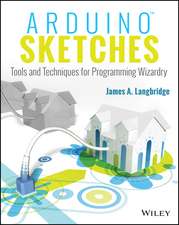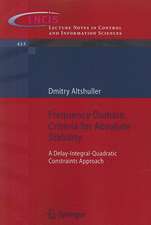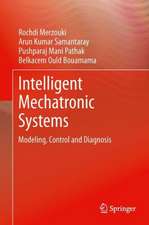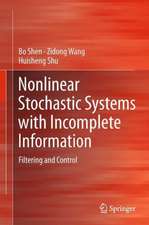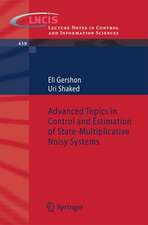Extremum-Seeking Control and Applications: A Numerical Optimization-Based Approach: Advances in Industrial Control
Autor Chunlei Zhang, Raúl Ordóñezen Limba Engleză Hardback – 27 oct 2011
| Toate formatele și edițiile | Preț | Express |
|---|---|---|
| Paperback (1) | 552.87 lei 38-45 zile | |
| SPRINGER LONDON – 23 aug 2016 | 552.87 lei 38-45 zile | |
| Hardback (1) | 631.53 lei 6-8 săpt. | |
| SPRINGER LONDON – 27 oct 2011 | 631.53 lei 6-8 săpt. |
Din seria Advances in Industrial Control
- 15%
 Preț: 643.34 lei
Preț: 643.34 lei - 23%
 Preț: 582.63 lei
Preț: 582.63 lei - 18%
 Preț: 783.98 lei
Preț: 783.98 lei - 18%
 Preț: 947.35 lei
Preț: 947.35 lei - 20%
 Preț: 568.24 lei
Preț: 568.24 lei - 15%
 Preț: 643.16 lei
Preț: 643.16 lei - 18%
 Preț: 899.21 lei
Preț: 899.21 lei - 18%
 Preț: 891.33 lei
Preț: 891.33 lei - 18%
 Preț: 740.57 lei
Preț: 740.57 lei - 18%
 Preț: 961.23 lei
Preț: 961.23 lei - 18%
 Preț: 955.08 lei
Preț: 955.08 lei - 15%
 Preț: 645.28 lei
Preț: 645.28 lei - 15%
 Preț: 638.43 lei
Preț: 638.43 lei - 18%
 Preț: 901.11 lei
Preț: 901.11 lei - 18%
 Preț: 1410.94 lei
Preț: 1410.94 lei - 18%
 Preț: 728.91 lei
Preț: 728.91 lei - 20%
 Preț: 1003.78 lei
Preț: 1003.78 lei - 18%
 Preț: 947.35 lei
Preț: 947.35 lei - 15%
 Preț: 643.34 lei
Preț: 643.34 lei - 15%
 Preț: 654.30 lei
Preț: 654.30 lei - 18%
 Preț: 950.52 lei
Preț: 950.52 lei - 15%
 Preț: 644.30 lei
Preț: 644.30 lei - 18%
 Preț: 1393.09 lei
Preț: 1393.09 lei - 18%
 Preț: 950.21 lei
Preț: 950.21 lei - 18%
 Preț: 949.90 lei
Preț: 949.90 lei - 18%
 Preț: 949.42 lei
Preț: 949.42 lei - 18%
 Preț: 950.52 lei
Preț: 950.52 lei - 18%
 Preț: 1113.71 lei
Preț: 1113.71 lei - 15%
 Preț: 650.04 lei
Preț: 650.04 lei - 15%
 Preț: 644.95 lei
Preț: 644.95 lei - 18%
 Preț: 950.33 lei
Preț: 950.33 lei - 18%
 Preț: 948.61 lei
Preț: 948.61 lei - 18%
 Preț: 1112.60 lei
Preț: 1112.60 lei - 15%
 Preț: 644.63 lei
Preț: 644.63 lei - 18%
 Preț: 953.20 lei
Preț: 953.20 lei - 18%
 Preț: 945.62 lei
Preț: 945.62 lei - 15%
 Preț: 640.88 lei
Preț: 640.88 lei - 15%
 Preț: 640.88 lei
Preț: 640.88 lei - 20%
 Preț: 650.92 lei
Preț: 650.92 lei - 18%
 Preț: 1112.60 lei
Preț: 1112.60 lei - 20%
 Preț: 998.36 lei
Preț: 998.36 lei - 15%
 Preț: 643.34 lei
Preț: 643.34 lei - 18%
 Preț: 948.92 lei
Preț: 948.92 lei - 18%
 Preț: 1381.43 lei
Preț: 1381.43 lei - 15%
 Preț: 651.51 lei
Preț: 651.51 lei - 15%
 Preț: 647.08 lei
Preț: 647.08 lei - 20%
 Preț: 563.66 lei
Preț: 563.66 lei - 18%
 Preț: 992.64 lei
Preț: 992.64 lei - 18%
 Preț: 1225.79 lei
Preț: 1225.79 lei
Preț: 631.53 lei
Preț vechi: 742.98 lei
-15% Nou
Puncte Express: 947
Preț estimativ în valută:
120.85€ • 129.22$ • 100.76£
120.85€ • 129.22$ • 100.76£
Carte tipărită la comandă
Livrare economică 18 aprilie-02 mai
Preluare comenzi: 021 569.72.76
Specificații
ISBN-13: 9781447122234
ISBN-10: 1447122232
Pagini: 224
Ilustrații: XVIII, 201 p.
Dimensiuni: 155 x 235 x 18 mm
Greutate: 0.17 kg
Ediția:2012
Editura: SPRINGER LONDON
Colecția Springer
Seria Advances in Industrial Control
Locul publicării:London, United Kingdom
ISBN-10: 1447122232
Pagini: 224
Ilustrații: XVIII, 201 p.
Dimensiuni: 155 x 235 x 18 mm
Greutate: 0.17 kg
Ediția:2012
Editura: SPRINGER LONDON
Colecția Springer
Seria Advances in Industrial Control
Locul publicării:London, United Kingdom
Public țintă
Professional/practitionerCuprins
Part I: Theory.- Introduction.- Design of Extremum-seeking Control.- Finite-time State Regulator Design.-Asymptotic State Regulator Design.- Part II: Applications.- Antilock Braking systems.- Swarm Tracking.- Impedance Matching.- Mobile Radar Network.- Appendix: Construction of Reference Signal.
Recenzii
From the reviews:
“The monograph is divided into two parts. In the first, the authors review existing analog-optimization-based ESC … . The second part of the book deals with applications of ESC … . The book will be of benefit to graduate students persuing their degrees in applied and industrial mathematics, as well as to researchers and engineers who may encounter optimal control methods in their work.” (Mikhail Yu Kokurin, Zentralblatt MATH, Vol. 1255, 2013)
“The monograph is divided into two parts. In the first, the authors review existing analog-optimization-based ESC … . The second part of the book deals with applications of ESC … . The book will be of benefit to graduate students persuing their degrees in applied and industrial mathematics, as well as to researchers and engineers who may encounter optimal control methods in their work.” (Mikhail Yu Kokurin, Zentralblatt MATH, Vol. 1255, 2013)
Textul de pe ultima copertă
Extremum seeking control tracks a varying maximum or minimum in a performance function such as a cost. It attempts to determine the optimal performance of a control system as it operates, thereby reducing downtime and the need for system analysis.
Extremum Seeking Control and Applications is divided into two parts. In the first, the authors review existing analog optimization based extremum seeking control including gradient, perturbation and sliding mode based control designs. They then propose a novel numerical optimization based extremum seeking control based on optimization algorithms and state regulation. This control design is developed for simple linear time-invariant systems and then extended for a class of feedback linearizable nonlinear systems.
The two main optimization algorithms – line search and trust region methods – are analyzed for robustness. Finite-time and asymptotic state regulators are put forward for linear and nonlinear systems respectively. Further design flexibility is achieved using the robustness results of the optimization algorithms and the asymptotic state regulator by which existing nonlinear adaptive control techniques can be introduced for robust design. The approach used is easier to implement than those that use perturbation based extremum seeking control, and tends to display a high level of robustness.
The second part of the book deals with a variety of applications of extremum seeking control:
· a comparative study of extremum seeking control schemes in antilock braking system design;
· impedance matching;
· source seeking, formation control, collision and obstacle avoidance for groups of autonomous agents; and
· mobile radar networks.
Extremum Seeking Control and Applications will interest academics and graduate students working in control, and industrial practitioners from a variety ofbackgrounds: systems, automotive, aerospace, communications, semiconductor and chemical engineering.
Extremum Seeking Control and Applications is divided into two parts. In the first, the authors review existing analog optimization based extremum seeking control including gradient, perturbation and sliding mode based control designs. They then propose a novel numerical optimization based extremum seeking control based on optimization algorithms and state regulation. This control design is developed for simple linear time-invariant systems and then extended for a class of feedback linearizable nonlinear systems.
The two main optimization algorithms – line search and trust region methods – are analyzed for robustness. Finite-time and asymptotic state regulators are put forward for linear and nonlinear systems respectively. Further design flexibility is achieved using the robustness results of the optimization algorithms and the asymptotic state regulator by which existing nonlinear adaptive control techniques can be introduced for robust design. The approach used is easier to implement than those that use perturbation based extremum seeking control, and tends to display a high level of robustness.
The second part of the book deals with a variety of applications of extremum seeking control:
· a comparative study of extremum seeking control schemes in antilock braking system design;
· impedance matching;
· source seeking, formation control, collision and obstacle avoidance for groups of autonomous agents; and
· mobile radar networks.
Extremum Seeking Control and Applications will interest academics and graduate students working in control, and industrial practitioners from a variety ofbackgrounds: systems, automotive, aerospace, communications, semiconductor and chemical engineering.
Caracteristici
Provides the reader with a new and more robust method of control for reducing plant downtime and time-consuming system analysis Presents several applications of extremum-seeking control demonstrating its practical appeal in diverse circumstances Provision of MATLAB®/Simulink® code gives readers a head start for implementing the algorithms descrived in their own applications Includes supplementary material: sn.pub/extras




